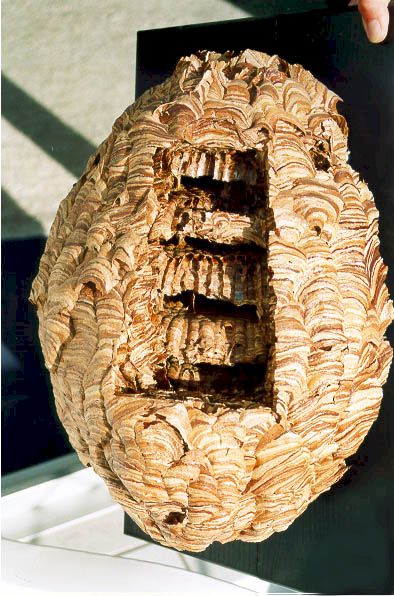Preserving and Displaying a
beautiful Hornet Nest
and
how to relocate Hornet- and Wasp nests

click on thumbnail to enlarge the image
The paper-like nests of Hornets are made of chewed wood fiber mixed with saliva. Hornet nests are frequently displayed in nature
centers, schools, and natural
history museums. They can also be displayed in the home as a conversation piece!
Below are answers to the most common questions about displaying a hornet's nest. How is the nest collected?
The easiest method of collecting a nest is to wait until after the
hornets have abandoned the nest in the fall (after the first hard freeze or by
beginning November). Hornet nests are annual; they last one summer and all
occupants freeze or die of old age in the fall. Collect the nest as soon as
possible because exposed, unprotected nests are subject to destruction by
wildlife and weather. Will I get stung from hornets that emerge from a
collected nest?
There will be few, if any hornets in a nest collected in late
fall. If you feel the need to be extra-cautious, leave the nest in a garage or
porch where it will be protected from the weather until mid-winter. Then bring
the nest indoors.
 Will the nest smell bad?
The carcasses of hornets and larvae that remain in a collected
nest may produce a mild odor before they completely dry up. If this is
unacceptable, leave the nest in a protected outdoor location as mentioned
above. Does the nest need to be treated with varnish to
preserve it?
No. It is not really necessary to treat the collected nest in any way.
The nest will last almost indefinitely if it is suspended in a dry location
where it will not be damaged by handling or vibration. But a good idea is any
way to spray the nest with a clear polyurethane seal. Will new hornets emerge from eggs that hatch after
the nest is hung indoors?
No. Hornet eggs laid inside the nest by the queen hatch into
grublike larvae that must be fed and cared for by the workers. If any eggs
hatched indoors the tiny larvae would perish.
Source:

http://www.ent.iastate.edu/
How to relocate Hornet- and
Wasp nests - experience of Mr. Kevin Foster
Hornet nests can be relocated but it is quite tricky. The way
I do it is to collect all the workers from the nest first with a net and
transfer these to a jar made with a 'lobster pot' one way top. For hornets and
Dolichovespula wasps I use a net as there are up to about 300 individuals in a
nest which is ok. You can net up to about 50 at a time and feed these into a pot.
Normally though there are much fewer workers as nests are best relocated early
in the season with only a few workers present. For Vespula nests a modified 12V
vacuum cleaner can be used which has a pot before the fan, like a pooter.
This technique I have also applied for Vespula and
Dolichovespula nests. Dolichovespula are by far the easiest being small and made
of the most strong paper.
Best wishes
Kevin
next Page: The
stinger

Hymenoptera>Vespoidea>Vespidae>Vespa
crabro>Hornisse>Hornet>Frelon>Hoornaar>Vespa
grande>Abejorro>Calabrone
Hymenoptera>Vespoidea>Vespidae>Vespa
crabro>Hornisse>Hornet>Frelon>Hoornaar>Vespa grande>Abejorro>Calabrone
Webmaster:
Dieter Kosmeier
Hymenoptera>Vespoidea>Vespidae>Vespa
crabro>Hornisse>Hornet>Frelon>Hoornaar>Vespa grande>Abejorro>Calabrone
Hymenoptera>Vespoidea>Vespidae>Vespa
crabro>Hornisse>Hornet>Frelon>Hoornaar>Vespa grande>Abejorro>Calabrone

www.vespa-crabro.de
|